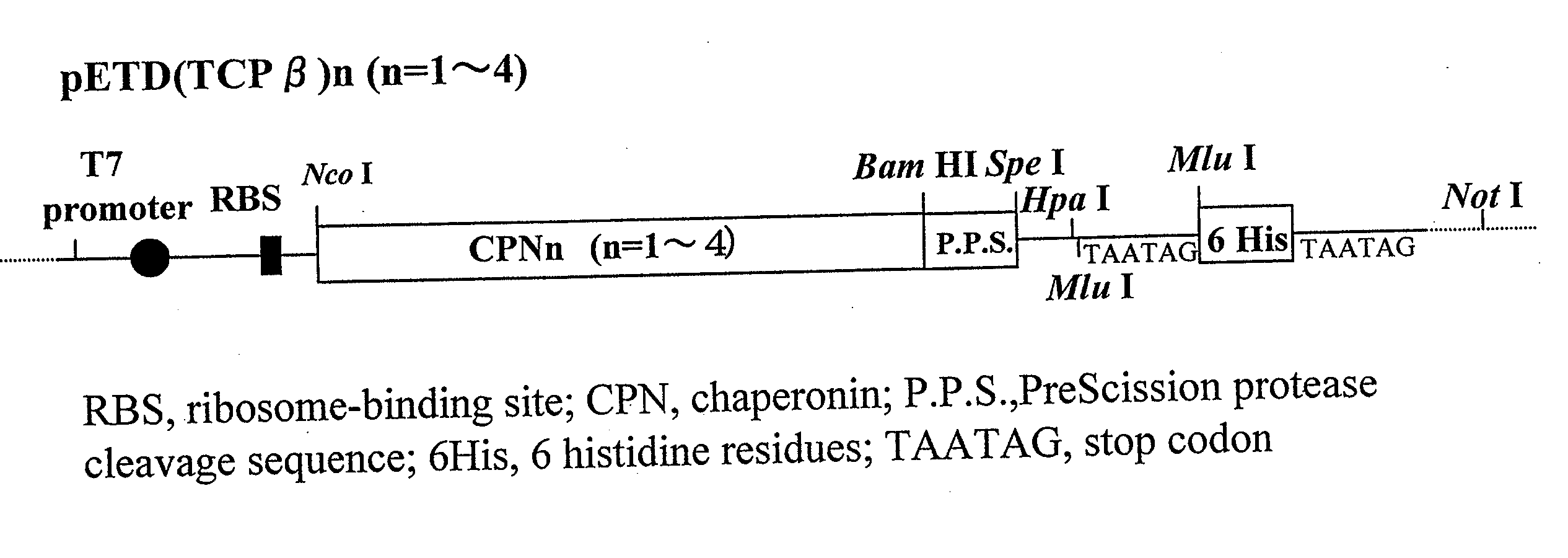Process for production of a recombinant protein and a fusion protein
a technology of fusion protein and recombinant protein, which is applied in the direction of polypeptides with his-tags, organic chemistry, peptides, etc., can solve the problems of inability to obtain a large amount of active protein, inability to achieve full confidence in protein production techniques using transgenic animals and plants, and inability to achieve full confidence in protein production techniques in recent years. to achieve the effect of preventing the expression of the toxicity of a desired protein
- Summary
- Abstract
- Description
- Claims
- Application Information
AI Technical Summary
Benefits of technology
Problems solved by technology
Method used
Image
Examples
example 1
Synthesis of Thermococcus KS-1 Strain Chaperonin β Subunit Linkage
[0066] A chaperonin β-subunit (TCPβ) gene shown in SEQ ID NO:1 was cloned by polymerase chain reaction (PCR) with Thermococcus KS-1 strain genome as a template. An expression vector pETD(TCPβ)n (n=1 to 4) having a T7 promoter, wherein a gene fragment having the TCPβ gene was linked 1, 2, 3 and 4 times in one direction, was constructed (FIG. 3). Each expression vector was introduced into E. coli BL21 (DE3) strain, which was then cultured at 30° C. for 24 hours in 2XY. T. medium (16 g Bactotrypton, 10 g yeast extract, 15 g / L NaCl) containing carbenicillin, to express a chaperonin β-subunit linkage. After culture, the recovered cells were disrupted by sonication and centrifuged to recover a supernatant which was then analyzed by SDS-PAGE (FIG. 4). From the result of SDS-PAGE, it could be confirmed that (TCPβ)n (n=1 to 4) was expressed in a large amount in the soluble cytoplasmic fraction.
example 2
Observation of a TCPβ Linkage Under a Transmission Electron Microscope
[0067] pETD(TCPβ)2 and pETD(TCPβ)4 were cleaved with M1uI and subjected to self-ligation to give expression vectors pETDH(TCPβ)2 and pETDH(TCPβ)4 for synthesizing recombinant proteins having 6 histidine residues added to the C-termini of a TCPβ dimer and a TCPβ tetramer respectively (see FIG. 3). After a BL21 (DE3) strain was transformed with the vectors, an extract of the E. coli expressing a chaperonin β-subunit linkage was obtained under the same conditions in Example 1. The microbial extract was treated by heating at 75° C. for 30 minutes at a concentration of 5 mg / mL protein, whereby the majority of E. coli-derived proteins were denatured and precipitated. The supernatant was recovered by centrifugation and applied onto a nickel chelate Sepharose column. After the column was washed sufficiently with 50 mM Na phosphate buffer (pH 7.0) containing 10 mM imidazole, and the fraction adsorbed onto the nickel chela...
example 3
Synthesis of a TCPβ Tetramer / HBs Antigen Fusion Protein)
[0069] A type B hepatitis virus surface antigen (HBs antigen) gene shown in SEQ ID NO:2 was provided at the 5′-terminus thereof with SpeI site and at the 3′-terminus with HpaI site by PCR, and then introduced into pETDH(TCPβ)4 treated previously with SpeI and HpaI, to construct an expression vector pETDH(TCPβ)4·HBs for synthesizing a TCPβ tetramer / HBs antigen fusion protein having 6 histidine residues introduced into the C-terminus. This vector was transformed into a BL21 (DE3) strain, and then the fusion protein was synthesized under the same conditions in Example 1. A soluble fraction of the disrupted E. coli cells was separated by SDS-PAGE and analyzed by Coomassie Brilliant Blue, and as a result, a band having a size corresponding to that of the fusion protein was detected (FIG. 4). After SDS-PAGE, the band was transferred onto a blotting membrane and subjected to Western blotting with anti-HBs antigen polyclonal antibody....
PUM
| Property | Measurement | Unit |
|---|---|---|
| molecular weight | aaaaa | aaaaa |
| height | aaaaa | aaaaa |
| inner diameter | aaaaa | aaaaa |
Abstract
Description
Claims
Application Information
 Login to View More
Login to View More - R&D
- Intellectual Property
- Life Sciences
- Materials
- Tech Scout
- Unparalleled Data Quality
- Higher Quality Content
- 60% Fewer Hallucinations
Browse by: Latest US Patents, China's latest patents, Technical Efficacy Thesaurus, Application Domain, Technology Topic, Popular Technical Reports.
© 2025 PatSnap. All rights reserved.Legal|Privacy policy|Modern Slavery Act Transparency Statement|Sitemap|About US| Contact US: help@patsnap.com



